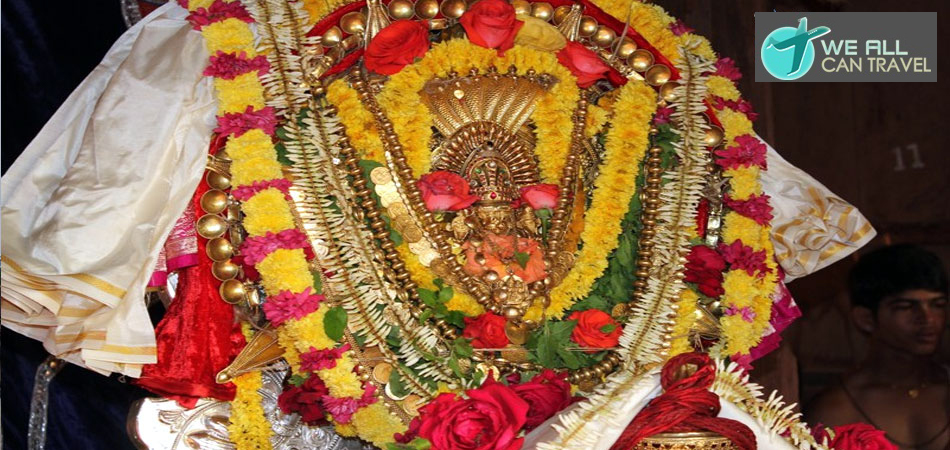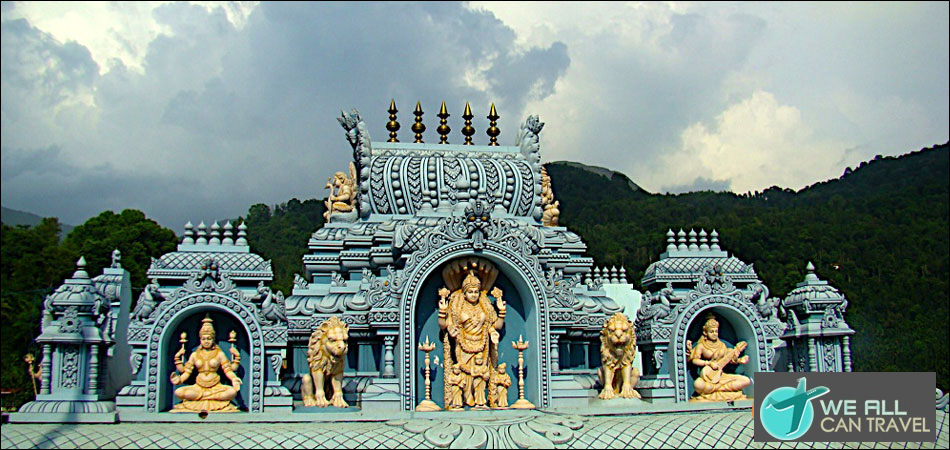History Of Kanaka Durga Temple
The temple of Kanaka Durga the Goddess of power, riches and benevolence and the presiding deity of Vijayawada, is swarmed by lakhs of pilgrims for worship during the "Navarathri" festival which is celebrated with Religious fervour, pomp and festivity. The small but ancient temple of Kanaka Durga , a top the Indrakeeladri hill on the banks of the Sacred river Krishna in Vijayawada abounds with legends of historical interest.
Indrakeeladri is unique in that it has been the chosen abode of Kanaka Durga and Her consort Malleswara as Swayambhu (the self-existent one). Here Durga is one the right side of Malleswara as against the tradition of Goddesses taking their position on the left of their consorts. This shows that Shakthi is predominant on the Indrakeeladri. Legend has it that the demons acquired great powers by appeasing the Gods and began harassing the sages on the earth.
Goddess Parvathi assumed various forms to kill these demons. It was kausiki to kill Sumbhu and Nisambhu, Mahisasura Mardini to kill Mahishasura and Durga to kill Durgamasura. "Kanaka Durga because she was aglow with golden hues, and prayed Her to stay on earth and bless them. Kanaka Durga asked Keeludu an ardent devotee to take the form of hill to enable Her stay on him. Thus Keeladri became the abode of Durga. She took the form of Mahisasura Mardini with eight arms holding different weapons, riding on a lion and trampling Mahishasura on the hill of Indrakeeladri. Her consort Shiva took his place on an adjacent hillrock as Jyothirlinga. He was worshipped by Lord Brahma with jasmines (Mallelu) whereby he got the name of Malleswara Swamy. As celestial beings like Indra visited the place, the hill came to be called Indrakeeladri.
Here it was according to another legend, that Arjuna performed penance and fought with Lord Shiva, who had appeared in the guise of Kiratha to win pasupathastra, the most powerful weapon. So this place is also called phalguna theertha.
When Indrakeeladri came in the way of the River Krishna the Gods requested the hill to allow the river to pass through it to join the sea. Keeludu obliged and gave a small passage for the river. But the ferocious Krishna made the passage larger than permitted and carried a part of the hill four miles downstream to Yanamalakuduru, where there is now a hillrock called "Thelukonda" or floating hillrock. According to another legend, Kanaka Durga borrowed the nose-stud of the Krishna and to avoid returning it jumped up the hill. Krishna vowed to take back her ornament by raising her level to the hill top by the end of kaliyuga
Adi-Sankaracharya visited the temple and installed the Srichakra and initiated workship of Kanaka Durga in vedic ways. Hiuan Tsang, a Chinese traveler wrote that he has seen many stone inscriptions in the vicinity of the temple that revealed historic events.
Palakethu Bhupaludu made two inscriptions in the period 1150-1240 A.D. One related to unimpeaching Madhava Varma the ruler of this area. The son of poor women was killed when he fell under the wheels of the chariot of the king's son.
When she sought justice, Madhava Varma's advisers said that he should be punished with death. But they felt that the offender being the son of the king, could be spared the punishment. When Madhava Varma shown his impartiality by punishing his son with death, there rained gold on Vijayawada and both the boys were blessed to live again.
In yet another incident Malleswara stood by one of his staunch devotees Sripathi Pandithaiah, who believed there was no other God by Malleswara; and his stubbornness made the people ostracize him and he was even refused fire. The enraged Pandithaiah sought the blessings of Malleswara and cursed the people that they would not get fire any more, for he had taken possession of it, packed it in a silk cloth and hung it on a branch of a Sami Vriksham. The people had to apologise to Pandithaiah at the instance of their King, to get back the fire.
The nine-day festival of Navarathri ends on Vijaya Dasami Day when people worship arms and perform ayudha Pooja. Local chieftains used to celebrate the festival with pomp. Once a police officer refused them permission to display their arms on Vijaya Dasami day.
He got a cable from that he was dismissed from service following many complaints against him. Terrified by the events, the Officer not only permitted the people to celebrate Vijaya Dasami but also took part in it. Later he got another cable canceling his dismissal order. Thenceforth, it became a tradition for policemen to celebrate Vijaya Dasami, which is still in vogue.
Kanaka Durga is specially decorated as Balatripura Sundari, Gayathri Annapoorna. Mahalakshmi, Saraswathi, Lalitha Tripura Sundari, Durga Devi, Mahissura Mardini and Raja Rajeswari Devi on each day of the Narvarathri festival. On Vijaya Dasami day, the deities are taken in a swan-shaped boat around the Krishna river, popularity known as "Theppotsavam".
Though a ghat road was laid in 1969, most of the pilgrims prefer to climb the steps leading to the temple an arduons task for women and children. Some devotees climb the hill, decorating the steps with turmeric powder and vermilion to redeem their pledge of Metla Pooja.
 >> Agasteeshwara Temple
>> Agasteeshwara Temple >> Anantha Padmanabhaswami Temple
>> Anantha Padmanabhaswami Temple >> Ananthasana Temple
>> Ananthasana Temple >> Annapoorneshwari Temple
>> Annapoorneshwari Temple >> Arunachaleshwar Temple
>> Arunachaleshwar Temple